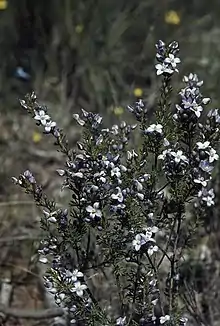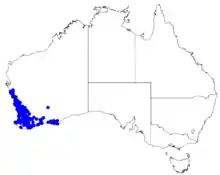Boronia ramosa
Boronia ramosa is a species of plant in the citrus family Rutaceae and is endemic to the southwest of Western Australia. It is an erect, mostly glabrous shrub with pinnate leaves with up to seven leaflets, and white, four-petalled flowers with blue or pale green backs.
| Boronia ramosa | |
|---|---|
 | |
| Boronia ramosa near Bindoon | |
| Scientific classification | |
| Kingdom: | Plantae |
| Clade: | Tracheophytes |
| Clade: | Angiosperms |
| Clade: | Eudicots |
| Clade: | Rosids |
| Order: | Sapindales |
| Family: | Rutaceae |
| Genus: | Boronia |
| Species: | B. ramosa |
| Binomial name | |
| Boronia ramosa | |
 | |
| Occurrence data from Australasian Virtual Herbarium | |
| Synonyms | |
|
Cyanothamnus ramosusLindl. | |
Description
Boronia ramosa is a slender, erect, mostly glabrous, woody shrub which grows to a height of 30 cm (10 in). The leaves are pinnate, 10–30 mm (0.4–1 in) long and have between three and seven leaflets on a petiole 1–11 mm (0.039–0.433 in) long. The leaflets are 5–15 mm (0.20–0.59 in) long. There are up to three flowers arranged in the leaf axils on pedicels 2–15 mm (0.079–0.591 in) long. The four sepals are thick, glabrous and egg-shaped, 1.5–5 mm (0.059–0.20 in) long. The petals are white with blue or pale green backs, broadly elliptic, 3–5 mm (0.12–0.20 in) long and prominently glandular. Flowering occurs from May to October.[2][3]
Taxonomy and naming
This species was first formally described in 1839 by John Lindley who gave it the name Cyanothamnus ramosus and published the description in A Sketch of the Vegetation of the Swan River Colony.[4][5] In 1863, George Bentham changed the name to Boronia ramosa.[6] The specific epithet (ramosa) is a Latin word meaning "full of branches".[7]
In 1971 and 1998, Paul Wilson described three subspecies that have been accepted by the Australian Plant Census:[8][9]
- Boronia ramosa subsp. anethifolia (Bartl.) Paul G.Wilson (previously Boronia ramosa var. anethifolia (Bartl.) Benth.)[10] has pedicels that are 2–3 mm (0.079–0.118 in) long and shorter than the leaves, with cylindrical leaflets that are channelled on the upper surface;
- Boronia ramosa subsp. lesueurana Paul G.Wilson[11] has pedicels that are 2–3 mm (0.079–0.118 in) long and shorter than the leaves, with linear to narrow oblong leaflets that are concave on the upper surface;
- Boronia ramosa (Lindl.) Benth. subsp. ramosa[12] has pedicels that are 6–15 mm (0.24–0.59 in) long and longer than the leaves.
Distribution and habitat
This boronia grows on slopes and hillsides, sometimes in disused gravel pits and is widespread in the southwest from near Shark Bay to near Esperance.[2][3] Subspecies anethifolia occurs between the Murchison River, the Stirling Range and Cape Le Grand, subspecies lesueurana is only known from near Mt Lesueur and subspecies ramosa mainly from the Darling Range.[9]
Conservation status
Boronia ramosa is classed as "not threatened" by the Western Australian Government Department of Parks and Wildlife.[3]
References
- "Boronia ramosa". Australian Plant Census. Retrieved 20 April 2019.
- Duretto, Marco F.; Wilson, Paul G.; Ladiges, Pauline Y. "Boronia ramosa". Australian Biological Resources Study, Department of the Environment and Energy, Canberra. Retrieved 20 April 2019.
- "Boronia ramosa". FloraBase. Western Australian Government Department of Parks and Wildlife.
- "Cyanothamnus ramosus". APNI. Retrieved 20 April 2019.
- Lindley, John (1839). A Sketch of the Vegetation of the Swan River Colonly (Appendix). Piccadilly: Jmes Ridgway. p. xviii. Retrieved 8 May 2019.
- "Boronia ramosa". APNI. Retrieved 20 April 2019.
- Brown, Roland Wilbur (1956). The Composition of Scientific Words. Washington, D.C.: Smithsonian Institution Press. p. 648.
- Wilson, Paul G. (1971). "Taxonomic notes on the family Rutaceae, principally of Western Australia". Nuytsia. 1 (2): 201. Retrieved 20 April 2019.
- Wilson, Paul G. (1998). "New names and new taxa in the genus Boronia (Rutaceae) from Western Australia, with notes on seed character". Nuytsia. 12 (1): 151–152. Retrieved 20 April 2019.
- "Boronia ramosa subsp. anethifolia". Australian Plant Census. Retrieved 20 April 2019.
- "Boronia ramosa subsp. lesueurana". Australian Plant Census. Retrieved 20 April 2019.
- "Boronia ramosa subsp. ramosa". Australian Plant Census. Retrieved 20 April 2019.